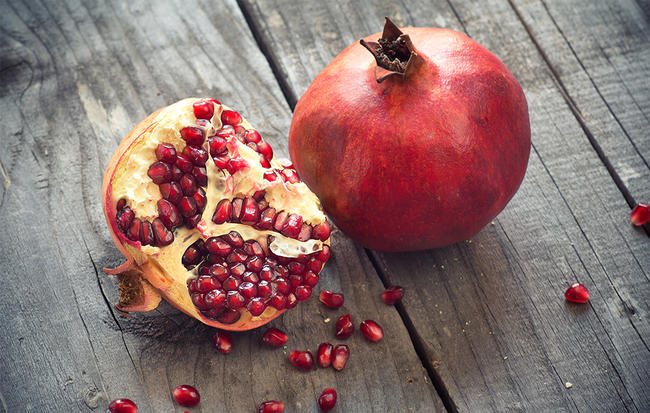Sure, celebrities tend to have expensive taste. But sometimes the simple things in life take the cake. After Kylie Jenner put boxes of pomegranate seeds front and center on her Snapchat last year, the whole internet naturally followed suit. The celebrity endorsement didn’t hurt, but the bright red fruit could have easily stood on its own thanks to its nutritional profile and tart, delicious flavor. There’s a reason why you’re seeing it in salads, snacks, fruit plates, and even desserts, and it doesn’t have to do just with a Kardashian.
Unlike some other trendy foods, pomegranate nutrition facts are not overhyped. It’s packed with polyphenols—a powerful antioxidant that helps protect your body’s cells from free-radical damage. It also has lots of other vitamins and minerals (which we’ll discuss later). But the short version: Eating pomegranates is just as good for your bod as it is for your taste buds.
There is a surprisingly diverse lineup of the fruit available. “Wonderful” is the most popular variety of pomegranates. They’re incredibly juicy, sweet, and boast a bright ruby hue, says Cindy Weinstein, president of the Florida Pomegranate Association and owner and operator of Green Sea Farms, which produces over 130 pomegranate mother trees for the University of Florida. White-seeded varieties like Sonoran and Eversweet are actually preferred in certain countries, she says. Other varieties, according to the Pomegranate Council, include Angel Red and Urbanekgranate.
While getting pomegranates from ripe to ready to de-seeded looks like no easy feat, the juice is definitely worth the squeeze. Here, all the pomegranate nutrition facts you need to know, plus how to de-seed pomegranates, eat them by the fistful, and get them ready for their social media close-ups.

WHEN ARE POMEGRANATES IN SEASON?
Grab pomegranates while they’re fresh during their short season of October, November, December, and January. However, Weinstein says you can find them year-round since they’re imported from countries like Chile and Peru.

HOW TO PICK THE BEST POMEGRANATE AT THE GROCERY STORE
Patricia Bannan, R.D.N., author of Eat Right When The Time Is Right and nutrition consultant for POM Wonderful, suggests choosing a pomegranate that feels heavy for its size. Don’t judge a fruit by its rind, however. You can still find juicy and sweet arils from a pomegranate whose skin looks dull in color.
Weinstein adds that when pomegranates are growing, they’re spherical, but as they mature they start looking hexagonal. This means they’re riper. While a little scuffing isn’t exactly Instagram material, it’s still fine to eat.

HOW TO STORE A POMEGRANATE
Store whole, uncut pomegranates on the counter for up to a week, says Weinstein. They can stay in the crisper for up to a month, but if you wrap them in a dry paper towel and stick them in a plastic bag, she’s seen them last for five months.
What to do with the seeds? According to the Pomegranate Council, the arils can be refrigerated for three days, or frozen for up to six months.

HOW TO DE-SEED A POMEGRANATE
The million-dollar question your guests will ask is “How on earth did you pry out each individual seed without staining your entire kitchen?” After all, you can’t really eat the skin or the white pith (the white skin on the inside).
The preferred method for seeding a pomegranate here at Women’s Health also doubles as a great stress reliever. Simply cut a pomegranate in half horizontally, then hold one of the halves upside down over a bowl. Strike the uncut side firmly with a wooden spoon (you can really whack the heck out of it!) to force the arils to fall out into the bowl. If the arils are truly stuck, give your fruit a gentle squeeze to help loosen up the seeds. Repeat with the other half of the pomegranate.
You can also try this technique from celebrity chef Akasha Richmond, courtesy of POM Wonderful. First, cut through the pomegranate about an inch from the crown. Discard the top. You’ll see an “aerial view” of the pomegranate, with arils divided into groups. Cut between each group of arils. Above a bowl of water, pull the sections apart. With your thumbs, gently nudge the arils out of the rind. The arils will drop to the bottom of the bowl. Discard fibers that float to the top. Then, drain and devour.

HOW TO COOK WITH POMEGRANATES
Whether you’re pounding ‘poms by the fistful or incorporating them into dishes, they’re the ultimate palate pleaser. Bannan’s suggests are super easy:
-Blend them into a smoothie for a seasonal alternative to berries. (Get healthy smoothie recipes from The Women’s Health Big Book of Smoothies & Soups.)
-Toss them into salads to add crunch, texture, and color.
-Sprinkle them over yogurt or oatmeal.
-Use them as garnish for festive holiday cocktails or mocktails.
Weinstein makes her own pomegranate syrup, which adds a kick to ice cream, coffee cake, lemon cake, and lemon bars. It’s super easy: Juice the arils, add sugar to taste, and reduce the mixture by half over the stove. Be sure to hand-press lightly when juicing to avoid releasing the pomegranates bitter tannins.

WHAT’S THE NUTRITIONAL VALUE OF A POMEGRANATE?
According to the USDA, you’ll get a cup of pomegranate arils for 144 calories, seven grams of fiber, 33 grams of carbohydrates, two grams of fat and three grams of protein.They’re also packed with antioxidants. According to Bannan, pomegranates’ high polyphenol content of 700 milligrams per eight-ounce glass helps fight free radicals that damage our body’s cells. Pomegranates are also a great source of potassium, an important electrolyte for healthy muscles.












